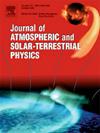On the retrieval of particle size information of noctilucent clouds from optical remote sensing measurements
IF 1.8
4区 地球科学
Q3 GEOCHEMISTRY & GEOPHYSICS
Journal of Atmospheric and Solar-Terrestrial Physics
Pub Date : 2025-02-04
DOI:10.1016/j.jastp.2025.106447
引用次数: 0
Abstract
Noctilucent clouds (NLCs) are optically thin ice clouds occurring near the polar mesopause in the summer hemisphere. Our understanding of the particle size of NLCs is to a large extent based on optical measurements in different observation geometries and optical NLC particle size retrievals are always based on a priori assumptions on the shape of the particle size distribution. The actual shape of the particle size distribution is generally not well known and can be assumed to be highly variable. In addition, the scattering cross section of NLC particles depends strongly on particle size. This leads to effects that have until now not been considered properly in the literature, i.e. if the assumed shape of the particle size distribution differs from the actual one, NLC size retrievals based on different measurement techniques will be associated with different biases. These differences can be quite substantial, for the retrieved particle number density in particular. In this study we carry out NLC particle size retrievals based on simplified synthetic forward simulations for the following observation techniques: satellite occultation, satellite limb-scatter, ground-based lidar and satellite nadir measurements. For the forward simulations we assume a bi-modal particle size distribution, while for the size retrieval a mono-modal distribution is assumed — which is typically the case in the literature. We assume both normal and log-normal particle size distributions, but the main results of this study are independent of the specific assumption on the shape of particle size distribution. We find that even for small deviations from the assumed shape of the particle size distribution, relatively large differences in retrieved size estimates occur between the different observation geometries considered. The retrieved median radii can differ by up to a factor of 2, while retrieved particle number densities can differ by more than a factor of 10 between the different observation geometries. These results need to be considered when comparing NLC size retrievals from different optical techniques.
基于光学遥感测量的夜光云粒径信息检索研究
夜光云是出现在夏季半球极层顶附近的光学薄冰云。我们对NLC粒度的理解在很大程度上是基于不同观测几何形状下的光学测量,而光学NLC粒度检索总是基于对粒径分布形状的先验假设。粒度分布的实际形状通常不为人所知,可以假设是高度可变的。此外,NLC粒子的散射截面与粒径有很大关系。这导致了迄今为止尚未在文献中得到适当考虑的影响,即如果假设的粒径分布形状与实际不同,则基于不同测量技术的NLC粒径检索将与不同的偏差相关联。这些差异可能是相当可观的,特别是对于检索到的粒子数密度。本文采用卫星掩星、卫星边缘散射、地面激光雷达和卫星最低点测量等观测技术,基于简化的综合正演模拟进行了NLC粒度反演。对于正演模拟,我们假设一个双峰的粒度分布,而对于粒度检索,一个单峰的分布是假设的-这是典型的情况下,在文献中。我们假设了正态和对数正态粒径分布,但本研究的主要结果与粒径分布形状的具体假设无关。我们发现,即使对粒径分布的假设形状有很小的偏差,在考虑的不同观测几何形状之间,检索到的粒径估计也存在相对较大的差异。检索到的中值半径可以相差2倍,而检索到的粒子数密度在不同的观测几何形状之间可以相差10倍以上。在比较不同光学技术的NLC尺寸检索时,需要考虑这些结果。
本文章由计算机程序翻译,如有差异,请以英文原文为准。
求助全文
约1分钟内获得全文
求助全文
来源期刊

Journal of Atmospheric and Solar-Terrestrial Physics
地学-地球化学与地球物理
CiteScore
4.10
自引率
5.30%
发文量
95
审稿时长
6 months
期刊介绍:
The Journal of Atmospheric and Solar-Terrestrial Physics (JASTP) is an international journal concerned with the inter-disciplinary science of the Earth''s atmospheric and space environment, especially the highly varied and highly variable physical phenomena that occur in this natural laboratory and the processes that couple them.
The journal covers the physical processes operating in the troposphere, stratosphere, mesosphere, thermosphere, ionosphere, magnetosphere, the Sun, interplanetary medium, and heliosphere. Phenomena occurring in other "spheres", solar influences on climate, and supporting laboratory measurements are also considered. The journal deals especially with the coupling between the different regions.
Solar flares, coronal mass ejections, and other energetic events on the Sun create interesting and important perturbations in the near-Earth space environment. The physics of such "space weather" is central to the Journal of Atmospheric and Solar-Terrestrial Physics and the journal welcomes papers that lead in the direction of a predictive understanding of the coupled system. Regarding the upper atmosphere, the subjects of aeronomy, geomagnetism and geoelectricity, auroral phenomena, radio wave propagation, and plasma instabilities, are examples within the broad field of solar-terrestrial physics which emphasise the energy exchange between the solar wind, the magnetospheric and ionospheric plasmas, and the neutral gas. In the lower atmosphere, topics covered range from mesoscale to global scale dynamics, to atmospheric electricity, lightning and its effects, and to anthropogenic changes.
 求助内容:
求助内容: 应助结果提醒方式:
应助结果提醒方式:


